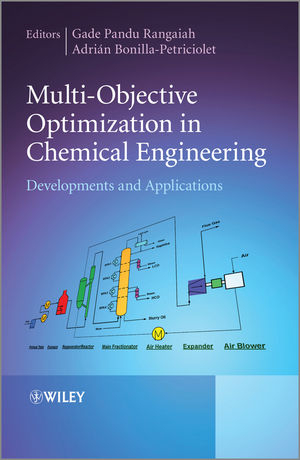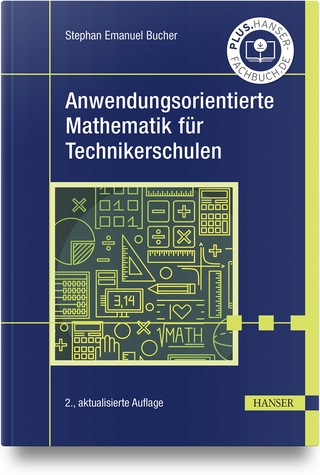
Multi-Objective Optimization in Chemical Engineering
John Wiley & Sons Inc (Verlag)
978-1-118-34166-7 (ISBN)
- Titel ist leider vergriffen;
keine Neuauflage - Artikel merken
For reasons both financial and environmental, there is a perpetual need to optimize the design and operating conditions of industrial process systems in order to improve their performance, energy efficiency, profitability, safety and reliability. However, with most chemical engineering application problems having many variables with complex inter-relationships, meeting these optimization objectives can be challenging. This is where Multi-Objective Optimization (MOO) is useful to find the optimal trade-offs among two or more conflicting objectives.
This book provides an overview of the recent developments and applications of MOO for modeling, design and operation of chemical, petrochemical, pharmaceutical, energy and related processes. It then covers important theoretical and computational developments as well as specific applications such as metabolic reaction networks, chromatographic systems, CO2 emissions targeting for petroleum refining units, ecodesign of chemical processes, ethanol purification and cumene process design.
Multi-Objective Optimization in Chemical Engineering: Developments and Applications is an invaluable resource for researchers and graduate students in chemical engineering as well as industrial practitioners and engineers involved in process design, modeling and optimization.
Gade Pandu Rangaiah has been with the National University of Singapore since 1982, and is Professor in the Department of Chemical & Biomolecular Engineering. His research interests are in control, modeling and optimization of chemical, petrochemical and related processes. Prof. Rangaiah published 130 papers in international journals and presented around 100 papers in conferences. He has received several awards for his teaching including Annual Teaching Excellence Awards from NUS for four consecutive years. He has edited two books for World Scientific, and has one book in production with Wiley. Adrian Bonilla-Petriciolet has been with the Instituto Tecnologico de Aguascalientes, Mexico, since 2001 and is currently Professor in the Department of Chemical Engineering and Head of Research Programs. His research interests include stochastic global optimization, applied thermodynamics, modeling and optimization of chemical processes. He has published more than 30 papers in international journals and refereed conference proceedings in the broad areas of process modeling and optimization.
Preface xv
Part I Overview
1 Introduction 3
Adrian Bonilla-Petriciolet and Gade Pandu Rangaiah
1.1 Optimization and Chemical Engineering 3
1.2 Basic Definitions and Concepts of Multi-Objective Optimization 5
1.3 Multi-Objective Optimization in Chemical Engineering 8
1.4 Scope and Organization of the Book 9
2 Optimization of Pooling Problems for Two Objectives Using the ε-Constraint Method 17
Haibo Zhang and Gade Pandu Rangaiah
2.1 Introduction 17
2.2 Pooling Problem Description and Formulations 19
2.3 ε-Constraint Method and IDE Algorithm 25
2.4 Application to Pooling Problems 27
2.5 Results and Discussion 28
2.6 Conclusions 32
3 Multi-objective Optimization Applications in Chemical Engineering 35
Shivom Sharma and Gade Pandu Rangaiah
3.1 Introduction 35
3.2 Multi-Objective Optimization Applications in Process Design and Operation 37
3.3 Multi-Objective Optimization Applications in Petroleum Refining, Petrochemicals, and Polymerization 57
3.4 Multi-Objective Optimization Applications in the Food Industry, Biotechnology, and Pharmaceuticals 57
3.5 Multi-Objective Optimization Applications in Power Generation and Carbon Dioxide Emissions 66
3.6 Multi-Objective Optimization Applications in Renewable Energy 66
3.7 MOO Applications in Hydrogen Production and Fuel Cells 82
3.8 Conclusions 82
Part II Multi-Objective Optimization Developments
4 Performance Comparison of Jumping-Gene Adaptations of the Elitist Nondominated Sorting Genetic Algorithm 105
Shivom Sharma, Seyed Reza Nabavi and Gade Pandu Rangaiah
4.1 Introduction 105
4.2 Jumping-Gene Adaptations 107
4.3 Termination Criterion 110
4.4 Constraints Handling and Implementation of Programs 112
4.5 Performance Comparison 114
4.6 Conclusions 124
5 Improved Constraint Handling Technique for Multi-objective Optimization with Application to Two Fermentation Processes 129
Shivom Sharma and Gade Pandu Rangaiah
5.1 Introduction 129
5.2 Constraint Handling Approaches in Chemical Engineering 131
5.3 Adaptive Constraint Relaxation and Feasibility Approach for SOO 132
5.4 Adaptive Relaxation of Constraints and Feasibility Approach for MOO 133
5.5 Testing of MODE-ACRFA 136
5.6 Multi-Objective Optimization of the Fermentation Process 139
5.7 Conclusions 153
6 Robust Multi-Objective Genetic Algorithm (RMOGA) with Online Approximation under Interval Uncertainty 157
Weiwei Hu, Adeel Butt, Ali Almansoori, Shapour Azarm and Ali Elkamel
6.1 Introduction 157
6.2 Background and Definition 159
6.3 Robust Multi-Objective Genetic Algorithm (RMOGA) 163
6.4 Online Approximation-Assisted RMOGA 168
6.5 Case Studies 172
6.6 Conclusion 178
7 Chance Constrained Programming to Handle Uncertainty in Nonlinear Process Models 183
Kishalay Mitra
7.1 Introduction 183
7.2 Uncertainty Handling Techniques 184
7.3 Chance-Constrained Programming: Fundamentals 186
7.4 Industrial Case Study: Grinding 193
7.5 Conclusion 206
8 Fuzzy Multi-objective Optimization for Metabolic Reaction Networks by Mixed-Integer Hybrid Differential Evolution 217
Feng-Sheng Wang and Wu-Hsiung Wu
8.1 Introduction 217
8.2 Problem Formulation 219
8.3 Optimality 223
8.4 Mixed-Integer Hybrid Differential Evolution 228
8.5 Examples 233
8.6 Summary 240
Part III Chemical Engineering Applications
9 Parameter Estimation in Phase Equilibria Calculations using Multi-Objective Evolutionary Algorithms 249
Sameer Punnapala, Francisco M. Vargas and Ali Elkamel
9.1 Introduction 249
9.2 Particle Swarm Optimization (PSO) 250
9.3 Parameter Estimation in Phase Equilibria Calculations 253
9.4 Model Description 253
9.5 Multi-Objective Optimization Results and Discussions 256
9.6 Conclusions 260
10 Phase Equilibrium Data Reconciliation using Multi-Objective Differential Evolution with Tabu List 267
A. Bonilla-Petriciolet, Shivom Sharma and Gade Pandu Rangaiah
10.1 Introduction. 267
10.2 Formulation of the Data-Reconciliation Problem for Phase Equilibrium Modeling 270
10.3 Multi-Objective Optimization using Differential Evolution with Tabu List 274
10.4 Data Reconciliation of Vapor-Liquid Equilibrium by MOO 277
10.5 Conclusions 287
11 CO2 Emissions Targeting for Petroleum Refinery Optimization 293
Mohmmad A. Al-Mayyahi, Andrew F.A. Hoadley and Gade Pandu Rangaiah
11.1 Introduction 293
11.2 MOO-Pinch Analysis Framework to Target CO2 Emissions 303
11.3 Case Studies 304
11.4 Case Studies 305
11.5 Conclusions 315
12 Ecodesign of Chemical Processes with Multi-Objective Genetic Algorithms 335
Catherine Azzaro-Pantel and Luc Pibouleau
12.1 Introduction 335
12.2 Numerical Tools 337
12.3 Williams–Otto Process (WOP) Optimization for Multiple Economic and Environmental Objectives 338
12.4 Revisiting the HDA Process 346
12.5 Conclusions and Perspectives 361
13 Modeling and Multi-objective Optimization of a Chromatographic System 369
Abhijit Tarafder
13.1 Introduction 369
13.2 Chromatography—Some Facts 371
13.3 Modeling Chromatographic Systems 373
13.4 Solving the Model Equations 376
13.5 Steps for Model Characterization 377
13.6 Description of the Optimization Routine—NSGA-II 387
13.7 Optimization of a Binary Separation in Chromatography 387
13.8 An Example Study 390
13.9 Conclusion 396
14 Estimation of Crystal Size Distribution: Image Thresholding based on Multi-Objective Optimization 399
Karthik Raja Periasamy and S. Lakshminarayanan
14.1 Introduction 399
14.2 Methodology 401
14.3 Image Simulation 402
14.4 Image Preprocessing 404
14.5 Image Segmentation 404
14.6 Feature Extraction 413
14.7 Future Work 417
14.8 Conclusions 418
15 Multi-Objective Optimization of a Hybrid Steam Stripper-Membrane Process for Continuous Bioethanol Purification 423
Krishna Gudena, Gade Pandu Rangaiah and S Lakshminarayanan
15.1 Introduction 423
15.2 Description and Design of a Hybrid Stripper-Membrane System 426
15.3 Mathematical Formulation and Optimization 431
15.4 Results and Discussion 435
15.5 Conclusions 445
15.5 Exercises 445
16 Process Design for Economic, Environmental and Safety Objectives with an Application to the Cumene Process 449
Shivom Sharma, Zi Chao Lim and Gade Pandu Rangaiah
16.1 Introduction 449
16.2 Review and Calculation of Safety Indices 451
16.3 Cumene Process, its Simulation and Costing 455
16.4 I2SI Calculation for Cumene Process 459
16.5 Optimization using EMOO Program 462
16.6 Optimization for Two Objectives 464
16.7 Optimization for EES Objectives 469
16.8 Conclusions 471
17 New PI Controller Tuning Methods Using Multi-Objective Optimization 479
Allan Vandervoort, Jules Thibault and Yash Gupta
17.1 Introduction 479
17.2 PI Controller Model 480
17.3 Optimization Problem 481
17.4 Pareto Domain 481
17.5 Optimization Results 488
17.6 Controller Tuning 490
17.7 Application of the Tuning Methods 491
17.8 Conclusions 498
Index
| Erscheint lt. Verlag | 28.5.2013 |
|---|---|
| Verlagsort | New York |
| Sprache | englisch |
| Maße | 175 x 252 mm |
| Gewicht | 943 g |
| Themenwelt | Mathematik / Informatik ► Mathematik ► Angewandte Mathematik |
| Mathematik / Informatik ► Mathematik ► Finanz- / Wirtschaftsmathematik | |
| Naturwissenschaften ► Chemie ► Technische Chemie | |
| Technik | |
| ISBN-10 | 1-118-34166-X / 111834166X |
| ISBN-13 | 978-1-118-34166-7 / 9781118341667 |
| Zustand | Neuware |
| Haben Sie eine Frage zum Produkt? |
aus dem Bereich


